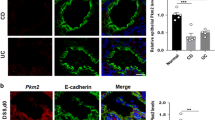Abstract
The transmembrane protein-tyrosine phosphatase (PTP) DEP-1 (density-enhanced phosphatase) is a candidate tumor suppressor in the colon epithelium. We have explored the function of DEP-1 in colon epithelial cells by inducible re-expression in a DEP-1-deficient human colon cancer cell line. Density-enhanced phosphatase-1 re-expression led to profound inhibition of cell proliferation and cell migration, and was associated with cytoskeletal rearrangements. These effects were dependent on the PTP activity of DEP-1 as they were not observed with cells expressing the catalytically inactive DEP-1 C1239S variant. shRNA-mediated suppression of DEP-1 in a colon epithelial cell line with high endogenous DEP-1 levels enhanced proliferation, further supporting the antiproliferative function of DEP-1. Nutrients, which are considered to be chemoprotective with respect to colon cancer development, including butyrate, green tea and apple polyphenols, had the capacity to elevate transcription of endogenous DEP-1 mRNA and expression of DEP-1 protein. Upregulation of DEP-1 expression, and in turn inhibition of cell growth and migration may present a previously unrecognized mechanism of chemoprevention by nutrients.
This is a preview of subscription content, access via your institution
Access options
Subscribe to this journal
Receive 50 print issues and online access
$259.00 per year
only $5.18 per issue
Buy this article
- Purchase on Springer Link
- Instant access to full article PDF
Prices may be subject to local taxes which are calculated during checkout





Similar content being viewed by others
References
Barth SW, Fähndrich C, Bub A, Dietrich H, Watzl B, Will F et al. (2005). Carcinogenesis 26: 1414–1421.
Glei M, Matuschek M, Steiner C, Böhm V, Persin C, Pool-Zobel BL . (2003). Toxicol In vitro 17: 723–729.
Gosse F, Guyot S, Roussi S, Lobstein A, Fischer B, Seiler N et al. (2005). Carcinogenesis 26: 1291–1295.
Iuliano R, Trapasso F, Le Pera I, Schepis F, Sama I, Clodomiro A et al. (2003). Cancer Res 63: 882–886.
Jandt E, Denner K, Kovalenko M, Östman A, Böhmer FD . (2003). Oncogene 22: 4175–4185.
Kautenburger T, Becker TW, Pool-Zobel BL . (2006). Int J Cancer Prev (in press).
Keane MM, Lowrey GA, Ettenberg SA, Dayton MA, Lipkowitz S . (1996). Cancer Res 56: 4236–4243.
Kellie S, Craggs G, Bird IN, Jones GE . (2004). J Cell Sci 117: 609–618.
Kovalenko M, Denner K, Sandström J, Persson C, Gross S, Jandt E et al. (2000). J Biol Chem 275: 16219–16226.
Lampugnani MG, Zanetti A, Corada M, Takahashi T, Balconi G, Breviario F et al. (2003). J Cell Biol 161: 793–804.
Le Pera I, Iuliano R, Florio T, Susini C, Trapasso F, Santoro M et al. (2005). Oncogene 24: 3187–3195.
Massa A, Barbieri F, Aiello C, Arena S, Pattarozzi A, Pirani P et al. (2004). J Biol Chem 279: 29004–29012.
Östman A, Yang Q, Tonks NK . (1994). Proc Natl Acad Sci USA 91: 9680–9684.
Palka HL, Park M, Tonks NK . (2003). J Biol Chem 278: 5728–5735.
Pool-Zobel B, Veeriah S, Böhmer FD . (2005a). Mutat Res 591: 74–92.
Pool-Zobel BL, Selvaraju V, Sauer J, Kautenburger T, Kiefer J, Richter KK et al. (2005b). Carcinogenesis 26: 1064–1076.
Richter M, Jurek D, Wrba F, Kaserer K, Wurzer G, Karner-Hanusch J et al. (2002). Eur J Cancer 38: 1937–1945.
Ruivenkamp C, Hermsen M, Postma C, Klous A, Baak J, Meijer G et al. (2003). Oncogene 22: 3472–3474.
Ruivenkamp CA, Van Wezel T, Zanon C, Stassen AP, Vlcek C, Csikos T et al. (2002). Nat Genet 31: 295–300.
Shimizu M, Deguchi A, Lim JT, Moriwaki H, Kopelovich L, Weinstein IB . (2005). Clin Cancer Res 11: 2735–2746.
Takahashi T, Takahashi K, St John PL, Fleming PA, Tomemori T, Watanabe T et al. (2003). Mol Cell Biol 23: 1817–1831.
Tenev T, Böhmer SA, Kaufmann R, Frese S, Bittorf T, Beckers T et al. (2000). Eur J Cell Biol 79: 261–271.
Trapasso F, Iuliano R, Boccia A, Stella A, Visconti R, Bruni P et al. (2000). Mol Cell Biol 20: 9236–9246.
Trapasso F, Yendamuri S, Dumon KR, Iuliano R, Cesari R, Feig B et al. (2004). Carcinogenesis 25: 2107–2114.
Acknowledgements
This work was supported by grants from the German Federal Ministry of Research and Education (BMBF), Grant 01EA0503 (to FDB and BP-Z), and by the Collaborative Research Center of the Deutsche Forschungsgemeinschaft SFB604, Project A1 (to FDB).
Author information
Authors and Affiliations
Corresponding author
Rights and permissions
About this article
Cite this article
Balavenkatraman, K., Jandt, E., Friedrich, K. et al. DEP-1 protein tyrosine phosphatase inhibits proliferation and migration of colon carcinoma cells and is upregulated by protective nutrients. Oncogene 25, 6319–6324 (2006). https://doi.org/10.1038/sj.onc.1209647
Received:
Revised:
Accepted:
Published:
Issue Date:
DOI: https://doi.org/10.1038/sj.onc.1209647
Keywords
This article is cited by
-
PTPRJ is downregulated in cervical squamous cell carcinoma
Journal of Genetics (2022)
-
iTRAQ plasma proteomics analysis for candidate biomarkers of type 2 incipient diabetic nephropathy
Clinical Proteomics (2019)
-
The intestinal barrier as an emerging target in the toxicological assessment of mycotoxins
Archives of Toxicology (2017)
-
The protein tyrosine phosphatase DEP-1/PTPRJ promotes breast cancer cell invasion and metastasis
Oncogene (2015)
-
Genetic alterations of protein tyrosine phosphatases in human cancers
Oncogene (2015)



